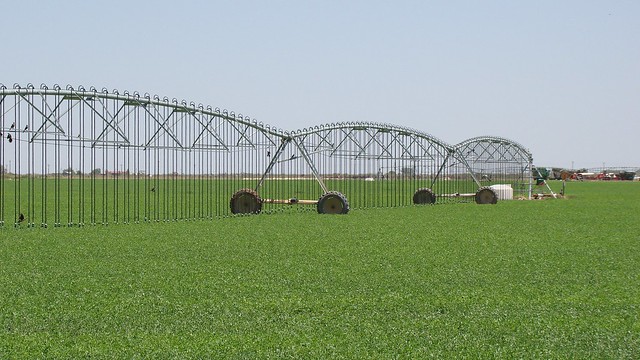
Joseph and Jeremy Gonzales are doing something different with their Gonzales Land and Cattle operation in Lovington, N.M., and it’s hard not to notice. Farming is hard enough without adding extra challenges. So the Gonzales brothers are using 21st-century technology to work smarter, not harder.
The Gonzaleses’ vibrant, green fields of alfalfa stand out from the surrounding brown fields. Some might wonder how these producers are beating the odds during the current drought—not to mention New Mexico’s perpetual wind.
The secret is in the water—not how much is used, but how it is applied to crops. Thanks to the USDA’s Natural Resources Conservation Service and its Environmental Quality Incentives Program, the Gonzales brothers replaced their antiquated and inefficient pivot systems with the Low-Elevation Spray Application (LESA) system.
“We are beginning and a little help allows us to implement practices such as the LESA system,” Jeremy says.

The LESA system provides a more even spray pattern so that most of the water dispensed reaches the soil. Other center pivot systems spray from a higher plane and are subject to solar and wind evaporation. The Gonzales brothers have also installed special nozzles and other additions to the system to make it even more efficient. And instead of having to physically drive to the pivot system or turn a nozzle, they can use an app on their smartphones.
“Even with the drought and persistent heat and wind we have actually seen yield increases,” Jeremy says.
The Ogallala Aquifer is the Gonzaleses’ main source of water. The aquifer, which is vital to U.S. agriculture, has been shrinking at a rapid, unsustainable rate, making conservation even more important.
In addition, the Gonzaleses have installed flow meters, chemigation valves and computerized pivot panels. The flow meters allow for a better measurement of the proper amount of water needed. The chemigation valve stops harmful pesticides and herbicides from entering groundwater.
The computerized pivot panels allow the brothers to remotely operate their equipment and to easily adjust the amount they are applying, and the pivot panels have a text messaging feature that alerts the Gonzales brothers of any problems the system encounters.
Get more information about USDA’s 2012 conservation results
Follow NRCS on Twitter
Check out other conservation-related stories on the USDA blog
